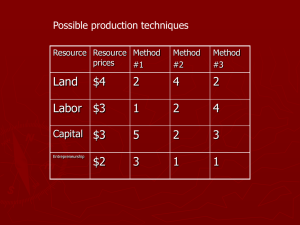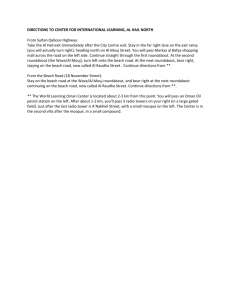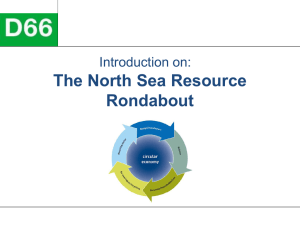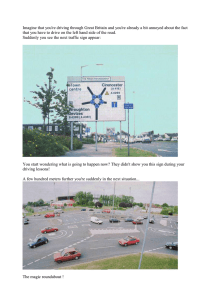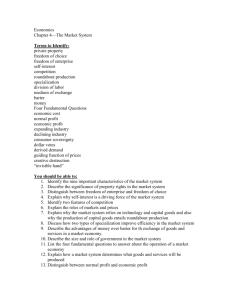– the Turbo-style roundabouts future? Union Street roundabout
advertisement
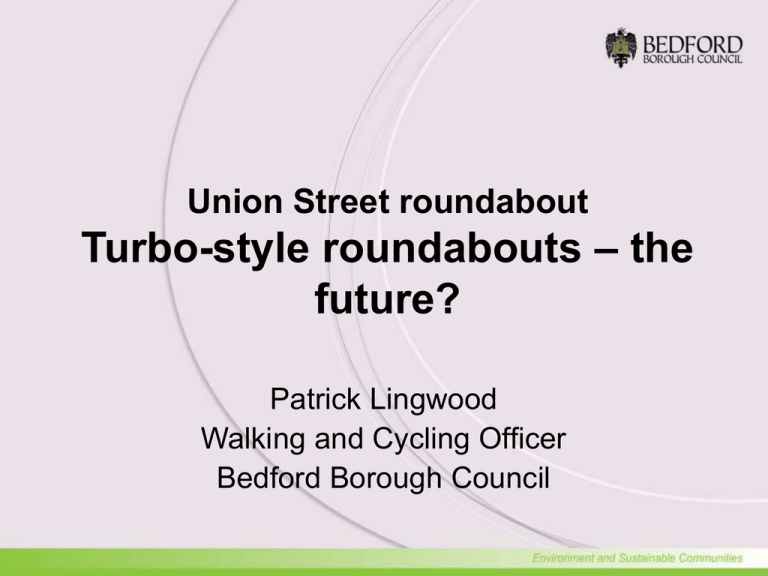
Union Street roundabout Turbo-style roundabouts – the future? Patrick Lingwood Walking and Cycling Officer Bedford Borough Council Presentation outline • Local importance and problems we faced • The evolution of the design – Dutch Turbo-roundabout – What it is and how it works • Crisis and redesign – Objections – Redesign principles • Picture gallery • Did it work? – Traffic capacity and queuing – Traffic Speed – Use of Zebras • The importance of the design Union Street roundabout A6 traffic Southbound A6 traffic Northbound Cycling and local traffic to/from station Union St Roundabout Town Centre Railway Station Bus Station Union St Roundabout Railway station 2010 Post code plots of children cycling to Biddenham Upper School Union St Roundabout Biddenham Upper School Pedestrian and Traffic Flows Busy multifunctional roundabout - flows per day (7am -7pm) – 25,000 motorised vehicles • 1000 lorries • 500 buses • 150 PTWs – 550 cyclists • 350 on-road and 200 off-road – 3000 pedestrians • 400 children Clapham Rd Roff Avenue Tavistock Street Union St roundabout Names of roads Union Street Union St Roundabout Railway station DfT cyclist safety grant • 2002 and 2012 36 casualties (8 serious) • 12 Cyclists: • 8 (1 serious) involved cyclists circulating • 1 serious a cyclist crossing at the arms • 24 others • 8 Pedestrians (3 serious) crossing at arms • 5 PTWs: (1 serious) • 13 Car drivers/passengers (2 serious) • The 10 year cost of accidents £1,823,000 Bicycle flows and accidents 350 on road & 200 off road Scale 1pt = 10 On-road Off-road Evolution of design DfT Cyclist Safety Bid 3 Objectives • Safety: – Reduce all injury accidents – especially to cyclists and pedestrians • Sustainability: – Encourage walking and cycling • Traffic: – no significant impact on capacity or queuing Designs evaluated Options compared 10 years costs Injuries Savings £ Savings Traffic impact KSI Slight KSI Slight KSI Slight £0 1 Do Nothing 8 24 0 0 -1481 -342 -1,823 Base 2 Compact on road 1 14 7 10 1,296 200 1,438 Yes 3 Compact offroad 3 15 5 9 926 214 1,140 Yes 4 Circulatory annular 5 22 3 2 556 28 584 No 5 Spiral annular 2 14 6 10 1,111 200 1,059 Yes 6 Signalised 2 14 6 10 1,111 200 1,311 Yes 7 Turboroundabout 2 14 6 10 1,111 200 1,311 No 12m central island radius 44m ICD 0m 10m 30m Roff Avenue/Tavistock Street/Clapham Road/Union Street Roundabout Option submitted to DfT Raised dividers 2 lane entries 2 circulating lanes where needed Raised dividers Spiral lanes Zebras and cycle crossings Compact style – entry, circulating, exit deflection Dutch findings: Capacity and safety • Capacity – Higher capacity than single lane compact roundabout • Safety – 40-70% safer than alternative junctions and safer than equivalent 2 lane (Dutch) concentric roundabouts • spiral lanes with fewer conflict points • slower speeds enforced by geometry Crisis and Redesign “Raised Dividers” Controversy • Objections by MAG (Motorcycle Action Group) • Meetings with DfT and Sustrans • Redesign – Same principles • speed reduction and spiral roundabout • “raised dividers” replaced by “virtual dividers” • opportunity to improve the design Raised dividers removed Extended kerbs with vertical posts Build outs on central island How the “virtual dividers” work Following lane results in 3 similar radii of curve Straightlining results in tighter radius of curve at extended kerbs Picture Gallery Did it work? Data collection • Data was collected at the roundabout at 3 times (7am – 7pm weekdays): • 2007: (Compact) – when the roundabout was operating as a single lane compact roundabout because of extended road works on gas mains • 2012: (Before) – when the roundabout was operating with typical unmarked wide 2 lane circulating carriageway • 2014 (After) – when the roundabout had been changed to a turbo-style roundabout with separated lanes and Zebra crossings on all arms All day traffic capacity 2007 Car Lgv Ogv1 Ogv2 Bus Mc Pc 2012 2014 0 5000 10000 15000 20000 25000 30000 Peak time capacity 2007 PM 2012 PM Car Lgv Ogv1 Ogv2 Bus Mc Pc 2014 PM 2007 AM 2012 AM 2014 AM 0 500 1000 1500 2000 2500 3000 AM Peak time Queuing (Roff Avenue metres) 160 140 2007 2012 2014 120 100 80 60 40 20 0 07:00 07:10 07:20 07:30 07:40 07:50 08:00 08:10 08:20 08:30 08:40 08:50 Speed surveys (circulatory carriageway free flow mph) 25 4mph Before After 20 A 8mph 15 B 10 5 6mph 0 5 6 7 8 9 10 11 12 13 14 15 16 17 18 19 20 21 22 23 24 25 26 -5 mph Typical cycle speed Benefits of slower speeds • More comfortable on-road cycling – Small difference between cyclist and vehicle speed • Safer (cycling) Zebra crossing – drivers more aware and willing to stop • Easier to get on roundabout – lower gap acceptance Crossing at the Zebras 2500 2000 Zebra/Pelican Without help 1500 1000 500 0 2012 2012 2012 Adults Children Cyclists 2014 2014 2014 Adults Children Cyclists Conclusion • So far, it all looks hopeful • Safety and capacity advantages of Dutch turbo-roundabouts • Virtual dividers make it easier to retrofit • Potential design for other busy urban roundabouts? Union St Roundabout Turbostyle Source Brilon 2008 “A scene of smooth tranquillity – it is so much easier to cross the roads with the pedestrian crossings and the sense of intimidation has gone for car and van drivers, too” – Graeme Hay BMF Patrick Lingwood Patrick.lingwood@bedford.gov.uk

